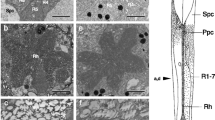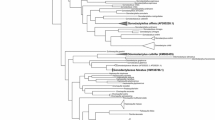Summary
The absorption maxima (λ max) of the visual pigments in the ommatidia ofNotonecta glauca were found by measuring the difference spectra of single rhabdomeres after alternating illumination with two different adaptation wavelengths. All the peripheral rhabdomeres contain a pigment with an extinction maximum at 560 nm. This pigment is sensitive to red light up to wavelengths > 700 nm. In a given ommatidium in the dorsal region of the eye, the two central rhabdomeres both contain one of two pigments, either a pigment with an absorption maximum in the UV, at 345 nm, or — in neighboring rhabdoms — a pigment with an absorption maximum at 445 nm. In the ventral part of the eye only the pigment absorbing maximally in the UV was found in the central rhabdomeres. The spectral absorption properties of various types of screening-pigment granules were measured.
Similar content being viewed by others
References
Bedau K (1911) Das Facettenauge der Wasserwanzen. Z Wiss Zool 97:417–456
Bennett R, Ruck P (1970) Spectral sensitivities of dark- and light-adaptedNotonecta compound eyes. J Insect Physiol 16:83–88
Bernard G (1979) Red-absorbing visual pigment of butterflies. Science 203:1125–1127
Bruckmoser P (1968) Die spektrale Empfindlichkeit einzelner Sehzellen des RückenschwimmersNotonecta glauca L. (Heteroptera). Z Vergl Physiol 59:187–204
Ebrey TG, Honig B (1977) New wavelength-dependent visual pigment nomograms. Vision Res 17:147–151
Giller P, McNeill S (1981) Predation strategies; resource partitioning and habitat selection inNotonecta (Hemiptera/Heteroptera). J Animal Ecol 50:798–808
Horridge GA (1968) A note on the number of retinula cells ofNotonecta. Z Vergl Physiol 61:259–262
Langer H (1975) Properties and functions of screening pigments in insect eyes. In: Snyder AW, Menzel R (eds) Photoreceptor optics. Springer, Berlin Heidelberg New York, pp 429–455
Langer H, Hamann B, Meinecke CC (1979) Tetrachromatic visual system in the mothSpodoptera exempta (Insecta: Noctuidae). J Comp Physiol 129:235–239
Langer H, Schlecht P, Schwemer J (1982) Microspectrophotometric investigation of insect visual pigments. In: Parker L (ed) Methods in enzymology, vol 81. Academic Press, New York, pp 729–741
Lythgoe JN (1972) The adaptation of visual pigments to the photic environment. In: Dartnall HJA (ed) Photochemistry of vision (Handbook of sensory physiology, vol VII/1). Springer, Berlin Heidelberg New York, pp 566–603
Meinertzhagen IA, Menzel R, Kahle G (1983) The identification of spectral receptor types in the retina and lamina of the dragonflySympetrum rubicundulum. J Comp Physiol 151:295–310
Rokohl R (1942) Über die regionale Verschiedenheit der Farbtüchtigkeit im zusammengesetzten Auge vonNotonecta glauca. Z Vergl Physiol 29:638–676
Schlecht P, Hamdorf K, Langer H (1978) The arrangement of colour receptors in a fused rhabdom of an insect. J Comp Physiol 123:239–243
Schwemer J, Langer H (1982) Insect visual pigments. In: Parker L (ed) Methods in enzymology, vol 81. Academic Press, New York, pp. 182–207
Schwind R (1983a) A polarization-sensitive response of the flying water bugNotonecta glauca to UV light. J Comp Physiol 150:87–91
Schwind R (1983b) Zonation of the optical environment and zonation in rhabdom structure within the eye of the backswimmerNotonecta glauca. Cell Tissue Res 232:53–63
Schwind R (1984) Evidence for true polarization vision based on a two-channel analyzer system in the eye of the water bugNotonecta glauca. J Comp Physiol A 154:53–57
Author information
Authors and Affiliations
Rights and permissions
About this article
Cite this article
Schwind, R., Schlecht, P. & Langer, H. Microspectrophotometric characterization and localization of three visual pigments in the compound eye ofNotonecta glauca L. (Heteroptera). J. Comp. Physiol. 154, 341–346 (1984). https://doi.org/10.1007/BF00605233
Accepted:
Issue Date:
DOI: https://doi.org/10.1007/BF00605233




